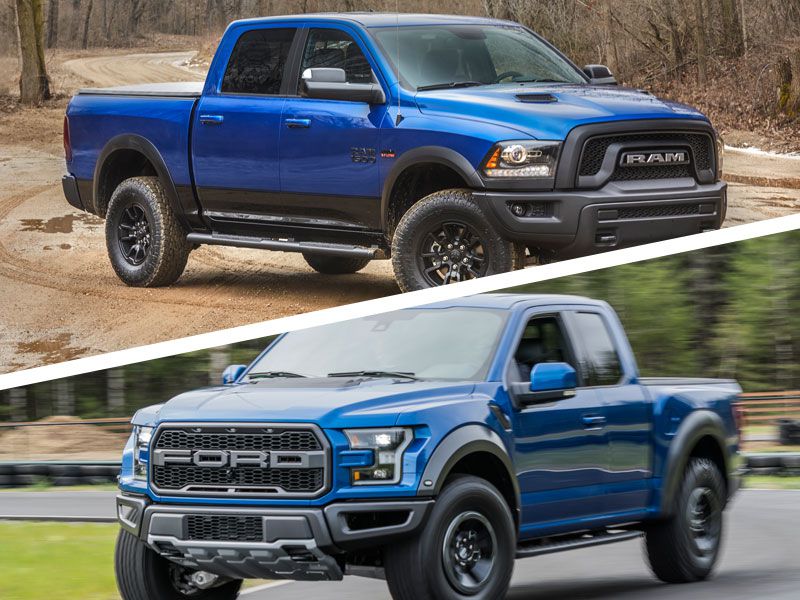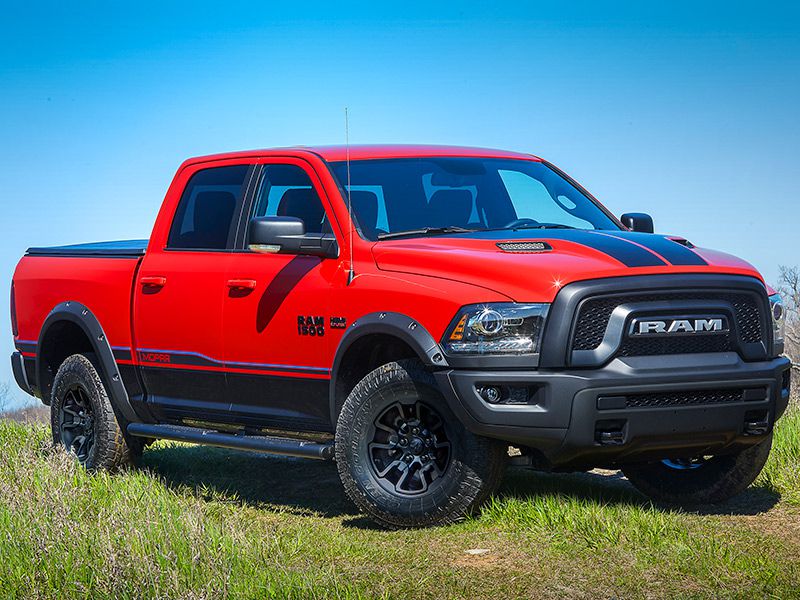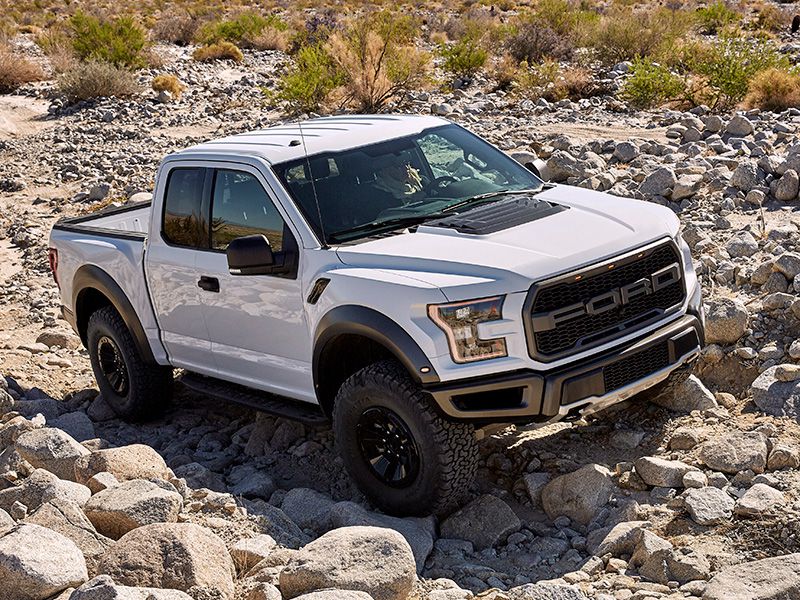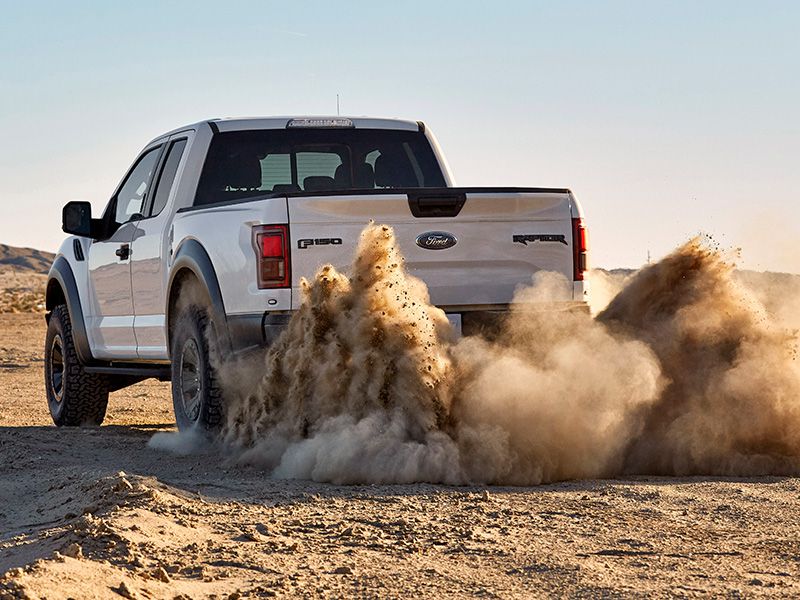Recent Articles
Popular Makes
Body Types
2017 Ford Raptor vs. 2017 Ram Rebel: Which is Best?

2017 Ford Raptor vs 2017 RAM Rebel ・ Photo by Ram Trucks / Ford
Trucks and SUVs have become extremely popular in recent years, and so have trucks that can act like SUVs. In fact, all of the major pickup-makers now offer off-road trucks, including Ford, Ram, Chevy, GMC, Toyota and Nissan. The resulting arms race has led to some amazing performers, too, so that today’s highly capable beasts are ready for some of the toughest terrain you can find. But if you want to eliminate the posers — and the midsize pickups — the question really comes down to this: Which is best, the all-new Ford Raptor or Ram Rebel?
Exterior Design
Although off-road performance is the No. 1 priority for both the Ram Rebel and Ford F-150 Raptor, designers also have made sure each truck is as eye-catching as it is capable. In some cases, that means emphasizing functional upgrades like front skid plates, massive off-road tires and assorted body modifications. Coincidentally, both trucks feature new blacked-out grilles with their brand names front and center. But the basic Ford design, relying on a traditionally prominent and vertically oriented grille shape, delivers a much more powerful presence than the Ram. Furthermore, the Raptor then complements its grille with futuristic headlight shapes that are just better-looking than the Rebel’s, at least in the opinion of Autobytel judges.
Ford also builds on its aesthetic advantages with handy exterior benefits such as LED cargo-box lighting, LED mirror-mounted spotlights, an integrated tailgate step and a twin-panel moonroof. And finally, the Raptor is available in both double- and crew-cab configurations, with the Rebel limited to the larger crew-cab setup with four full-size doors.

Photo by Ford
Interior Design
The Rebel and F-150 Raptor show off distinctive high-performance style cues inside, too. In terms of style, the Ram is more successful. Consider the front seats, which have the same pattern as the tread design on the Rebel’s off-road tires. Additionally, the Ram provides standard heating for its front row, along with a leather-wrapped and heated steering wheel, a 10-way power-adjustable driver’s seat, a six-way power-adjustable front-passenger seat—none of which is standard on the Raptor.
However, since this is supposed to be a competition between two trail-friendly trucks, not a pair of premium pickups, we actually give the nod to the Ford here. After all, it does have plenty of luxuries of its own — including ventilated front seats the Rebel can’t match — and it also has an unbeatable functionality benefit with its available double-cab body style.

Photo by Ford
Engines and Transmissions
We’ll let the numbers do the talking here, starting with the Ford Raptor’s standard second-generation EcoBoost engine. Still displacing 3.5 liters, this brand-new twin-turbo unit serves up 450 horsepower and 510 lb-ft of torque. Not only is that 39 more horses and 76 more lb-ft of torque than found in the previous Raptor’s engine, it’s also an advantage of 145 horsepower and a whopping 241 lb-ft of torque versus the Rebel’s standard naturally aspirated V6. Even taking into account the Ram’s optional 5.7-liter Hemi V8, the Ford’s output exceeds the Ram’s by 55 hp and 100 lb-ft of torque. Also new is the Raptor’s standard 10-speed automatic transmission; it has more cogs than the eight-speed setup standard in the Rebel.

Photo by Ford
Towing and Payload Ratings
Though the Raptor can supply significantly more output than the Rebel, the Ram can make better use of its power for hauling motorized toys and/or other cargo. More specifically, the entry-level Rebel, with its standard V6, has a tow rating of 7,130 pounds and a payload of 1,410 lbs. The Ford truck can tow up to 6,000 lbs in its standard double-cab configuration and has a payload of 1,000 lbs. In terms of available configurations, the Hemi-powered Rebel provides tow and payload ratings of 9,350 lbs and 1,200 lbs, respectively, while the Raptor crew cab checks in with tow/payload limits of 8,000/1,200 lbs. That works out to more than double-digit percentage advantages for the Rebel in nearly all scenarios.

Photo by Ram Trucks
Off-Road Capability
At the heart of the matter, of course, are the off-road performance capabilities of the Ford Raptor and Ram Rebel. Now, rather than go into the details about the trucks’ hardware, departure and approach angles, wading depths, etc., we’re going to focus on what that stuff really means for customers.
In that regard, you should keep in mind that the Raptor was engineered for optimum performance in relatively high-speed desert running. Indeed, you may recall that Ford tested a pre-production 2017 Raptor by successfully putting a stock version through the Baja 1000 desert race. The Rebel, for its part, is more of a traditional off-roader and was designed to be at home on rockier trails and in other more typical off-road conditions — which is the kind of broader appeal we prefer in our trucks.

Photo by Fiat Chrysler Automobiles
Fuel Economy
It’s also worth remembering that the Raptor’s impressively powerful engine is impressively thirsty as well: Ford claims combined EPA ratings for the truck have jumped 23 percent versus the previous-gen Raptor, yet that only raises the bar to 15 mpg city/18 mpg highway/16 mpg combined (with standard four-wheel drive).
On the other hand, the Ram Rebel isn’t exactly a fuel-sipper. Oh, it’s certainly more efficient than the Ford, but that’s with four-wheel drive V6 ratings of 16 mpg city/23 mpg highway/19 mpg combined, plus EPA marks of 15 mpg city/21 mpg highway/17 mpg combined with V8 motivation and four-wheel drive. (Note: The rear-wheel drive Ram, with a V8, can post an EPA line of 15/22/17.)

Photo by Ram Trucks
Safety
Ford has become a safety leader in the full-size pickup segment, and that carries over to its off-road high-performer. Thus, the Raptor can leverage a five-star overall NHTSA safety rating from the standard F-150 lineup, while the RAM 1500, which underpins the Rebel, scored just four out of five stars.
Technology-wise, the Rebel and Raptor each furnish rearview cameras and rear parking sensors, but the Ford caps off its victory in the safety category by also providing a blind-spot monitor, adaptive cruise control, forward collision warning, lane-departure warning, a 360-degree camera with split-screen display and the unique Pro Trailer Backup Assist system, which makes reverse-steering with a trailer easier than ever.

Photo by Ford
Pricing and Value
At first glance, the Ram Rebel seems like a near-bargain compared to the Ford Raptor. The MSRP of the Ram, for instance, is $45,095 — $4,170 less than the starting price of a Raptor; in other words, shoppers would have to pay a little more than 9 percent more to get the Ford. The thing is, that price is for a rear-wheel drive Ram. Moving up to four-wheel drive requires an extra $2,100 for Ram buyers, but that’s for a V6 engine. If you want the Rebel’s Hemi V8 and four-wheel-drive — to compete against the Ford’s standard 4WD and robust EcoBoost V6 — the Ram’s cost comes up to $49,145.
Then, with the impact on your bank account so similar, it’s a question of whether you prefer factors like the Ram’s superior towing power or the Raptor’s still-more powerful engine. In the real world, we’d pick the Ram.

Photo by Ram Trucks
Infotainment Technology
The Raptor and the Rebel both offer some of their brands’ top infotainment technologies, complete with generously sized touchscreens, navigation, SiriusXM Satellite Radio/Traffic/Travel Link service, and premium audio options. But as the newer truck, the Raptor also brings newer tech resources that include Android Auto and Apple CarPlay smartphone integration for a serious connectivity advantage. Further, turning to the trucks’ standard tech content, only the Ford comes straight from the factory with a voice-activated infotainment setup with hands-free calling; that’s an extra-cost option on the Rebel.

Photo by Ford
Final Thoughts
Today’s test of tough trucks is especially tough to call. Yes, the Ford Raptor won five of our nine categories, but the Ram Rebel leads the way in some of the most important ones, including for off-road performance and hauling power.
At the end of the day, with this being a competition between two off-road trucks — and despite Ford’s safety benefits — that’s also enough for us to recommend the Rebel as providing the superior real-world experience for many owners.

Photo by Ram Trucks